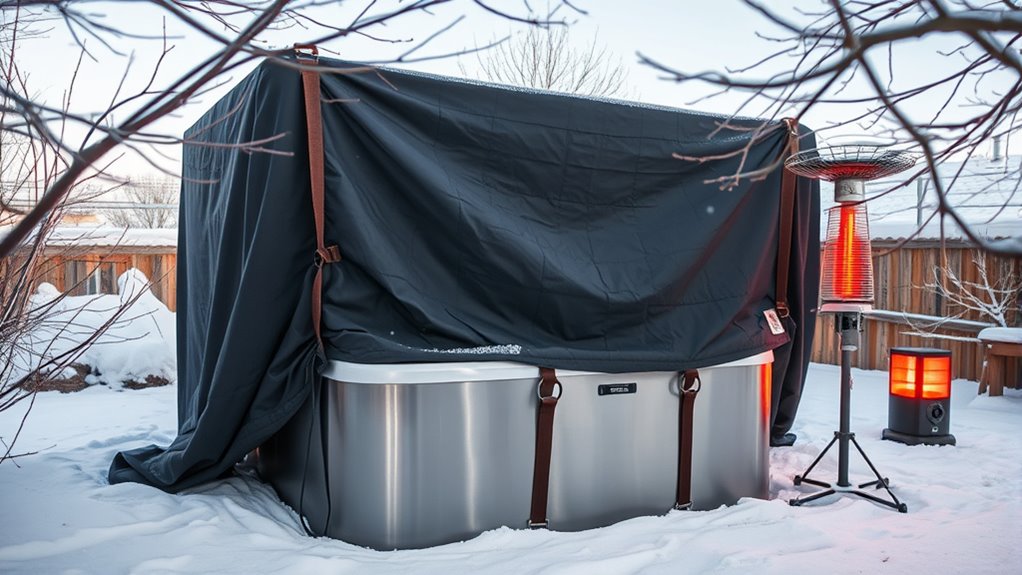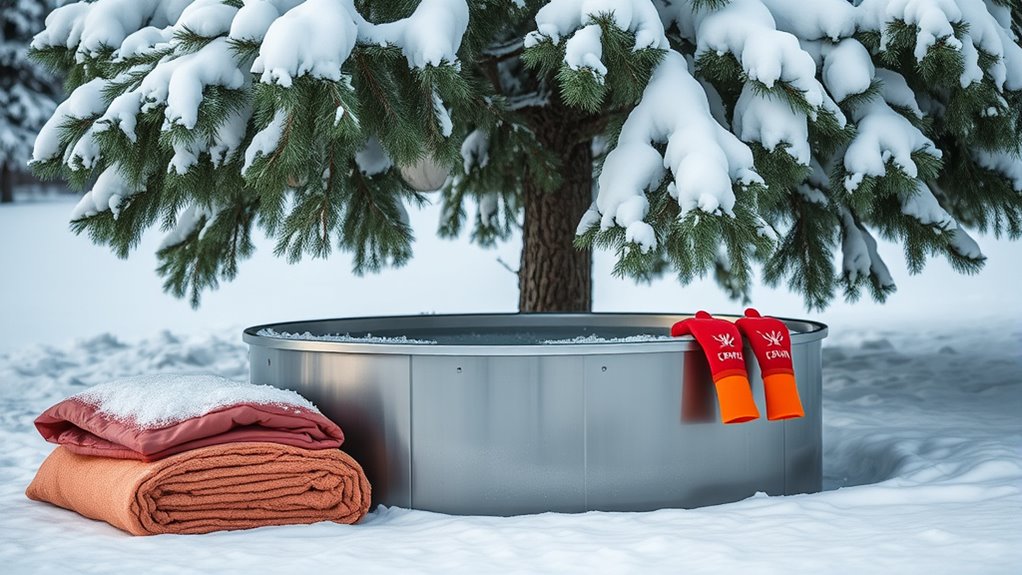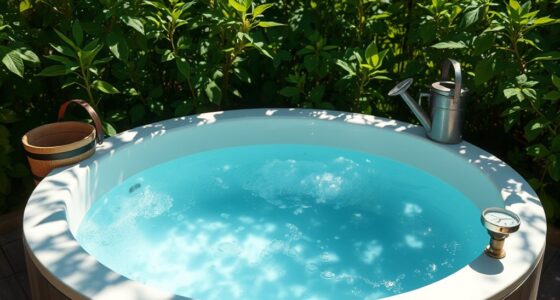To winterize your cold plunge tub and prevent freezing, start by installing a waterproof, insulated cover to keep out moisture and maintain stable temperatures. Drain all plumbing lines and add antifreeze solutions where needed to protect against ice expansion. Keep an eye on the weather and consider wrapping exposed pipes with insulation or using portable heaters for extra warmth. Taking these steps will help guarantee your tub stays intact through the cold months, and there’s more you can do to prepare effectively.
Key Takeaways
- Use high-quality waterproof covers to shield the tub and minimize heat loss during winter.
- Add non-toxic antifreeze to water and plumbing lines following manufacturer instructions.
- Drain all plumbing lines and consider adding antifreeze to prevent ice damage.
- Monitor weather forecasts and insulate exposed pipes; use temporary heat sources if necessary.
- Combine covers, antifreeze, drainage, and weather precautions for comprehensive winter protection.

As winter approaches, preparing your cold plunge tub to withstand freezing temperatures is essential. If you neglect this step, the water can freeze, damaging the tub’s structure and plumbing. The first line of defense is investing in a high-quality waterproof cover. A sturdy cover keeps debris out and minimizes exposure to the cold air, which helps maintain a more stable temperature inside the tub. Make sure the cover fits snugly to prevent heat loss and guarantee it’s waterproof to keep moisture and snow from seeping in and causing additional issues. A good cover is especially important if you plan to leave your tub outside during the winter months, as it provides an extra layer of insulation and protection against harsh weather conditions. Proper insulation methods can further enhance protection by reducing heat loss and preventing freezing.
In addition to covers, antifreeze solutions are an effective way to prevent freezing of the water and the plumbing components. You can add non-toxic, food-grade antifreeze designed specifically for pools and spas to the water, following manufacturer instructions for the correct mixture ratio. This creates a protective barrier that lowers the freezing point of the water, helping to keep it from freezing even in extremely cold temperatures. Be cautious not to overuse antifreeze, as excessive amounts can affect water quality or damage the tub’s components. Regularly check the water level and antifreeze concentration to guarantee maximum protection throughout the winter.
Another important step is draining the plumbing lines if you won’t be using the tub for an extended period. Remove any drain plugs or valves to drain out residual water, which can freeze and expand, cracking pipes and fittings. Once drained, consider adding antifreeze solutions directly into the plumbing lines to prevent any remaining moisture from freezing. This extra precaution helps protect delicate pipes and fittings from damage caused by expanding ice.
Lastly, keep an eye on the weather forecast. If an unexpected cold snap is predicted, take additional precautions such as wrapping exposed pipes with insulation or using temporary heat sources like a small space heater or heat lamp nearby. These measures provide extra warmth and help guarantee your cold plunge tub remains intact and functional through the winter months. By combining waterproof covers, antifreeze solutions, draining lines, and monitoring the weather, you can confidently winterize your cold plunge tub and enjoy it year-round without worry of damage from freezing temperatures.
Frequently Asked Questions
Can I Winterize My Cold Plunge Tub if I Live in a Mild Climate?
Yes, you can winterize your cold plunge tub even in a mild climate. While extreme freezing isn’t a concern, winter protection helps sustain the tub’s condition and prevents potential damage from occasional cold snaps. You might consider draining and covering your tub or adding a simple insulation layer. This proactive approach ensures your cold plunge stays in great shape and ready for use year-round, regardless of mild winter temperatures.
Is It Necessary to Drain the Tub Completely During Winterization?
A stitch in time saves nine, so you should drain your cold plunge tub completely during winterization. This helps meet drainage requirements and prevents freezing damage. If water remains, it can freeze and crack your tub, causing costly repairs. By draining it fully, you reduce the risk of freezing, ensuring your tub stays safe and ready for use when warmer weather returns. Always follow manufacturer instructions for best results.
How Often Should I Check My Cold Plunge Tub During Winter?
You should check your cold plunge tub at least once a week during winter. Regular inspections help you spot any issues early, while temperature monitoring guarantees the water doesn’t freeze. Keep an eye on the water level and look for cracks or leaks. If you notice any sudden changes in temperature or water quality, take immediate action to prevent damage. Consistent checks keep your tub safe and ready for use.
Are There Eco-Friendly Options for Winterizing My Cold Plunge Tub?
Are eco-friendly options available to winterize your cold plunge tub? Absolutely! You can use biodegradable antifreeze, which is safe for the environment and effective at preventing freezing. Additionally, solar-powered covers are an eco-conscious choice, harnessing sunlight to keep your tub warm naturally. These solutions help protect your tub while reducing your ecological footprint, making winter maintenance both responsible and sustainable.
Can I Use a Cover Instead of Winterizing My Cold Plunge Tub?
Using a cover alone isn’t enough to prevent freezing in your cold plunge tub. Cover alternatives like insulated tarps or thermal blankets help retain heat, but insulation options such as foam or bubble wrap provide added protection against the cold. You should combine a sturdy cover with proper insulation to make certain your tub stays safe and functional during winter. Relying solely on a cover leaves your tub vulnerable to freezing temperatures.
Conclusion
By winterizing your cold plunge tub, you’re not just protecting your investment—you’re safeguarding your wellness routine from the icy grip of winter. Think of it as wrapping your tub in a warm, sturdy blanket, shielding it from the harshest cold. With these simple steps, you’ll enjoy invigorating dips all season long, unbothered by the frost. Stay vigilant, stay warm, and let your cold plunge be your wintertime sanctuary—frozen no more.









